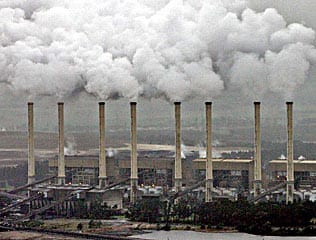Australia will need to rid itself of coal power generation completely by 2035 if it has any hope of meeting its obligations under the Paris Climate Agreement, the Climate Institute has warned in a submission on the nation’s climate policy framework tabled on Wednesday.
The Climate Institute issued the “hurry along” to the federal government in the wake of new global temperature and emissions records, calling on it ratchet up policy to replace coal-fired power with clean energy by 2035 and achieve net zero emissions by 2050.

In its submission to the Climate Change Authority’s review of Australia’s policy framework, the Climate Institute said that – in the absence of a carbon pricing mechanism – this would be the only policy consistent with Australia’s commitments to the Paris Climate Agreement.
“To set Australia on a credible path to net zero emissions, existing high emissions generation needs to be replaced with zero emissions power generation,” the submission reads.
“A domestic carbon price of >$70-$120/tonne would be needed during the 2020s to begin an orderly transition.
“Yet, signalling a domestic carbon price of this magnitude seems to be politically infeasible over the next couple of years.
To be serious about its recent Paris climate commitments, it said, Australia needed a targeted strategy to replace traditional coal fired power with clean energy by 2035 and achieve net zero emissions by 2050.
“Global temperatures are smashing records right now and Australia’s emissions are rising again,” said Climate Institute CEO John Connor.
“The nation’s climate and energy policies lack the credible objectives, the tools and the urgency needed to back recent international commitments, let alone build an innovative, safer, zero pollution Australian economy.”
“We need to move beyond arguments about the value of carbon pricing and provide a policy framework that can do the job.
“There can be no durable policy framework without an objective for zero emissions; carbon budget analysis; and electricity market direct action to replace our ageing and inefficient coal burning power stations with clean energy,” Connor said.
The Climate Institute’s call to quit coal in less than 20 years follows the Queensland Labor government’s endorsement, overnight, of the development of Adani’s massive Carmichael coal mine.

Greenpeace Australia, who described the show of support as “unbelievable”, said in a statement that the government had seemingly forgotten that it the Carmichael mine gets built, the coal will be burnt.
Meanwhile, carbon market analysts RepuTex released new research on Tuesday which suggested that more than half of Australia’s 2030 emissions reduction task could be met using “cheap and abundant” domestic abatement methods.
“Australia has got its own source of really low-cost credits, which means there is potentially no need to use international credits,” Reputex executive director Hugh Grossman told RE. “We can focus Australian policy on local emissions reduction and do it low-cost.”
But focusing Australian climate policy on mechanisms that actually do something has proven difficult for the federal Coalition, even after a change of Prime Minister.
Rather than responding with urgency, environment minister Greg Hunt recently made the “extraordinary” – and unsupported – claim that Australia’s greenhouse gas emissions actually “peaked” 10 years ago.
“My best estimate is that we are unlikely as a nation ever to surpass [2005 levels] … In my best judgment, the advice, the information from the department, we reached peak emissions in 2005-06 … and the course of history to come for Australia is that we will continue to be below that figure.”
Of course, this is not the case, as the Climate Institute’s Connor notes.
“Here in Australia there is drift and uncertainty in climate and energy policy. The Emissions Reduction Fund is reportedly losing budget support and ‘safeguard mechanisms’ impose little or no limits or responsibility on big emitters. Emissions are rising again.
“There are some welcome new initiatives under investigation but investors, business and citizens face a long delay potentially till the end of next year for a planned review to be concluded. The ALP has important elements like a net zero objective by 2050, but is yet to release a comprehensive strategy,” he said.
“Committing to pursue efforts to keep global warming below 1.5˚C – 2˚C above pre-industrial levels means we have to achieve net zero emissions well before mid-century. You can’t achieve that objective, and the Paris commitments, without an orderly and timely plan to modernise and clean up our electricity system.”
“Failure to deliver a policy framework aligned with a credible pathway to net zero emissions risks prolonging investment uncertainty and a much more rapid and disruptive change at a later date. There’s no plan for climate change, no plan for our future, without a plan for a zero carbon Australia backed by modern, smart and clean energy.”










